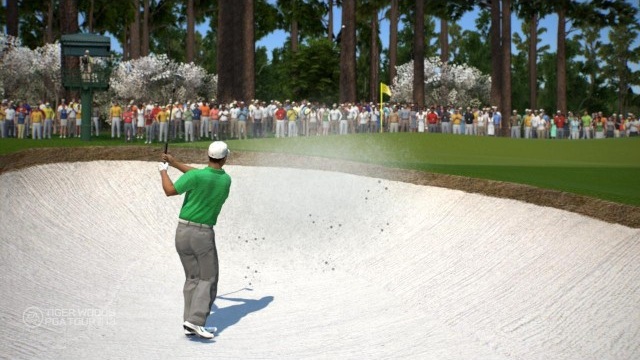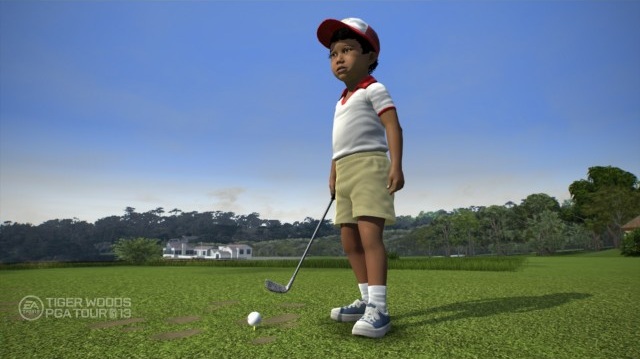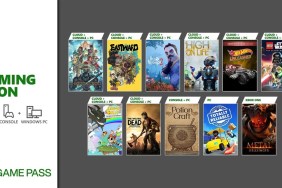Pst, want some coins?
Perhaps Tiger Woods is making a comeback. He finally climbed atop the leaderboard this past Sunday at the Arnold Palmer Invitational, marking his first PGA Tour win since September 2009. Shocking, I know. It's taken him awhile to gain his footing since his sexting scandal, fire hydrant incident, failed marriage, and worldwide shame, not to mention the loss of numerous sponsorships. EA Sports luckily wasn't one of them, though his image hardly graced the box art for last year's Tiger Woods title, in favor of The Masters as the new focus. This year, Tiger Woods is back on the cover, as if EA Sports knew he would make a rebound all along.
Likewise, Tiger Woods PGA Tour 13 has made several noteworthy changes, the most drastic of which is the removal of the three-click swing. Casual players will likely scoff at this, since one of the best self-esteem boosters is scoring 24 under par in only one round of 18 holes. It's the kind of achievement that would make someone daintily flick their hand away as if it's nothing. This time around, you have no option but to use the analog stick (left or right) to swing the club.
It can be awkward and overly sensitive at first, but anyone who can flick the analog stick straight up and down should have little trouble on the Amateur difficulty setting. Though it can make judging the power for wedge shots and putting rather finicky, the challenge of the analog stick controls are even-handed and manageable.
A part of this ease, if you select it in the options, is the returning caddie system. Set on automatic, the caddie will give you one or two preset but modifiable golf swings, with actual previews of how the ball will land and carry. Set on manual, the caddie will just give you a list of hints that you can follow at your behest. Either way, it will almost nullify the planning and calculation behind each swing, although it's to your benefit to learn how to judge the wind, the ball lie, the ball carry, and other factors for yourself since online tournaments usually have the caddie option set off.
The attention to realism can't be denied. Instead of merely selecting a fade or draw with the golf swing, the golfer now changes stance to make the fade and draw possible. If you're playing on a harder difficulty, fade and draws also require you to swing diagonally. Both the tempo and overswing are considered in a shot, so swinging straight isn't the only thing to concentrate on.
For an even more realistic experience, you can utilize the new Kinect controls where you swing parallel to the television screen. Placing your hand on your forehead will zoom the camera to the ball's intented location and crouching will let you see your lie. With all the menu navigation, though, it's certainly slower than using the controller, but at least it utilizes both the voice and tracking technology of the Kinect. (Still embarrassing to use with relatives watching…)

The only hitch in is that the presentation is getting stale, with many duplicated models in the crowd and audio that repeats and cuts out on occasion. The course themselves are true to their real-life counterparts, but zooming in at any patch of grass or tree shows how dated the textures are. The options for creating a customized golfer hasn't improved much either. The loss of a replay channel (with no EA GamerNet) also makes any amazing hole-in-ones literally forgettable.
If you're up to the challenge, you're free to slide the difficulty bar higher. Like the Forza Motorsport series, you'll earn an increased multiplier for any options you select beyond the easiest default settings. It's a welcome change that rewards experts who can tame the sensitivity of the analog stick and want a more realistic interpretation of golf. Since I can usually claim 18 under par on any course on Amateur, I push the AI difficulty to Hard for some extra experience.
Still, nudging the difficulty beyond Amateur only makes clearing objectives for sponsors as well as Silver and Gold Mastery on courses more irritating than they need to be. A created golfer also earns the majority of experience points by nailing birdies and eagles, so even with the increased multiplier, it's usually not in your best interest to switch to Pro or Tournament difficulty if you want to build your created golfer's stats.
As for online offerings (online pass required), in addition to the standard assortment of online tournaments on various difficulties, the new highlight is on the formation of clubs. Up to 25 players can rally together to form a clubhouse that has its own tournaments, message board, and tracking system where members can compete against each other for weekly awards. Its main benefit is to award members a bonus to the rate of coins they receive, though the boost is a paltry percentage in the low single digits.

And that's the trouble: The progression is stretched too thin. The idea is to match the slow grind of actual golf with an even slower progression, but the intention is probably more business-oriented than that. This year's system revolves around the acquisition of coins, which you can use to purchase packs of pins that give temporary bonus stats. The XP multiplier for created golfers, at 5 or more times the standard rate, is extremely desirable. The problem is that the lowest pack is worth 4,000 coins and a full 18-hole course that takes around a half an hour earns about 600 coins. Doing a little math, that means you need to spend an average of 3.5 hours just for one pack. Compared to the unlockable system in Hot Shots Golf, this feels stingy and yawn-inducingly monotonous.
Certainly, the boost packs borders on being optional, and you can get value out of completing the usual career mode and the new Tiger Legacy mode, where you must accomplish goals set through Tiger's life from his television appearance at age 2 through to his dream future of beating Jack Nicklaus' 18 career majors. (Playing as Tiny Tiger is a little unsettling, actually.) But a large part of the new design centers around getting coins, not just for packs, but for earning the privilege of playing on downloadable courses.
Unlike last year's title, you don't have to skip an event in career mode just because you don't have the DLC course; you can either change the course entirely or purchase rounds for the DLC course, with the carrot being that you can earn unlimited rounds on it by achieving Gold Mastery. The objectives for getting Gold Mastery isn't so much difficult—in fact, they are much more doable than before—as they are exorbitantly laborious. Earning Gold Mastery requires that you play through a course at least six times because one objective asks you to get 100 pars or better. So how many coins do you need to purchase six rounds of a DLC course? 24,000 coins. That's about 20 hours of work, and that's just 1 of 16 DLC courses. I'm winded just talking about.

That's where the microtransaction model comes into play. The game makes it very clear that there's an option for you to spend additional money on coins. There's even a $75 transaction at a 25% discount for 280,000 coins. (You wanna buy the game over?) Perhaps it's too bold to accuse the developers for deliberately making the coin acquisition slow so that these microtransactions look that much more instantly gratifying. But it wouldn't be so troubling if these coins where used only to purchase clothing or something aesthetic, as they can be used toward boosts that can be applied to online tournaments. It just feels like there's a junkie selling "steroid" coins around every corner.
Tiger Woods PGA Tour 13 would have been a stellar sports title, with its new emphasis on realism and online clubs, if it traded its microtransactional model for a fairer coin system. No one likes buying a $60 title that thinks it's free to play. If you actually put in the work—the weeks upon weeks of effort playing the game—you still feel shorted by people who put in less work but have more money to spend. Of course, if you spend money, you've just bought into the scheme. Somehow, Tiger Woods PGA Tour 13 is as much a financial test of character as it is a test of gameplay skill, and that's unfortunately as memorable as any sort of comeback.
-
Emphasis on realism
-
Analog controls replacing three-click swing
-
Online clubs
-
Clothing no longer tied to stats
-
A $60 free-to-play game?
-
Very slow progression system, very slow coin acquisition
-
Presentation looking dated











